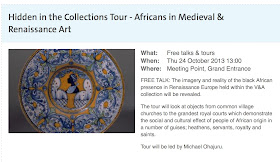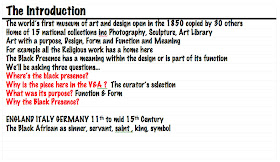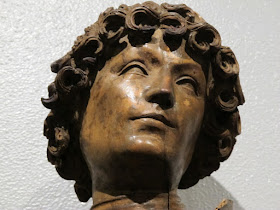 |
| The V&A's web notification of my tour! |
No plan survives contact with the enemy. Sun Tzu ‘Art of War’
Back in the Eighties (1980s) Art of War was essential reading whenever one had a task to do as business planning and delivery were seen as war! So you planned accordingly.
The Plan
I was invited to introduce a group of upto 24 people to the hidden black presence in seven personally selected works from the V&A’s collection, in the course of a 75 minute walk and talk, the pieces were spread over six floors of the V&A.
I created
a summary sheet of my chosen pieces to be used as a handout on the day.
V&A Piece
|
Black Presence
|
|
|
Heathen
|
|
|
Servant
|
|
|
Saint
|
|
|
King
|
|
|
Duke
|
|
|
Moor’s Head
|
|
|
Moor’s Head
|
|
|
Moor’s Head
|
Timings
I had worked and walked the route a number of times so I had a good idea of the walk time – the time to walk from piece to piece - between each black presence.
Total talk time (T) plus total walk time (W) had to be 75mins. From experience W was found to be 20 minutes, leaving 55 minutes for talking. Further all the presences – heathen, king saint and so on - were to be allocated the same time with the exception of the moor heads for which I wanted to discuss three related moor’s head presences. So, t was the time I would talk on 5 presences plus t/3 on each of two of the moor’s heads plus t/2 for the talk’s intro. So we have
Intro + 5 *( presence talk) + 2 *(moor’s head talk) = 55min
t/2 + 5*t + 2*t/3 = 55
t = 8
Which resulted in the following approximate times:
Piece (Black Presence)
|
Talk (min)
|
Walk (min)
|
Introduction
|
4
|
|
Orphrey (Heathen)
|
8
|
2
|
Altarpiece (Servant)
|
8
|
2
|
Sculpture (Saint)
|
8
|
4
|
Stained Glass (King)
|
8
|
2
|
Cameo (Duke)
|
8
|
2
|
Jug (Moor’s Head)
|
2
|
6
|
Sienna Plate (Moor’s Head)
|
2
|
1
|
Urbino Plate (Moor’s Head)
|
8
|
1
|
Total
|
55
|
20
|
Talk Structure
I structured each eight minute talk based on asking and answering a series of questions:
Where is the black?
A game for the audience to find and physically examine the black presence (briefly) on their own, before I presented it.
Why is the piece where it is in V&A?
The things which made the curator at one of the world’s leading art and design museum decide to display this piece here.
What was the purpose of the work?
Continuation of the previous question looking into exactly how the piece worked in its day.
What did the black presence mean?
How the black presence related to the previous two questions, if at all, and what it might have meant culturally at the time
Any Questions?
So, I had a plan with a structure written up on cards and with timings, I was ready to engage ‘the enemy’!
Introduction
 |
| My Notes for the Introduction |
The group assembled in the v&A's Grand Entrance on time – 1pm - about 20 with some faces I recognized to ease the pressure or as well as some members of the V&A staff – to add to it! Rather than give my introduction in the reception I preferred to give it in the V&A s Medieval and Renaissance (MedRen) wing itself so we moved over .
 |
| The V&A's Medieval and Renaissance Wing |
Using the MedRen’s exhibits I was keen to emphasize that the V&A was a museum of practical art: art with a purpose. And that we were we going to look at pieces whose purpose was a combination of the heavenly, in glorifying God and the earthly, in acknowledging aka bigging up the patron.
The V&A s MedRen wing is such an open, light and airy space full of the most wonderful objects, brilliantly presented and curated which when coupled to a willing attentive audience made it real easy to present. I finished my introduction by giving them the talk’s structure and the black presences I ‘d be discussing with them. I was carried away and ranted on beyond the allocated time by a some minutes. Sadly, my poor time keeping was to get worse.
Also forgot to appoint an ‘official photographer’ so regreatblly I have no scene setting shots or visual record of my tour.
 |
| My Notes for the Orphery |
The V&A has excellent introductory overviews of the different forms of
the black presence in its collection, specifically of interest where the websites dedicated to the black presence in its various manifestations in the Renaissance:
I used these texts as the basic input for the presences I was not familiar with, in particular the Duke (1510 -1537) , as his active period 1520-37 was strictly speaking out of my period as I followed the Open University Course AA315's dates c.1420-1520 - old habits die hard!
I spent some time – too much - discussing the scene with the character flagellating Christ as he carries the cross.
 |
| Christ and 'Simon of Cyrene' |
The
V&A catalogue entry for the orphery describes this scene as “Christ carrying the Cross (aided by Simon of Cyrene)”. I question the use of the word ‘aided’ here as you can see ‘Simon of Cyrene’ is clearly whipping rather aiding.
The Bible does not support this whipping, rather it speaks of Simon of Cyrene ‘bearing’ the cross.
Matthew 27.32 & Mark 15.21 [Simon of Cyrene] is compelled to bear [the] cross
Luke 23.26 [Simon of Cyrene] ‘bear[s]’ the cross for Christ
Examples of [Simon of Cyrene] 'bearing' Christ's cross are to found in a number of works in the V&A for example in this
carved mother of pearl piece from theV&A collection, which shows a diminutive Simon bearing the rear of the cross.
However Simon of Cyrene might indeed have been dark skinned as depicted, as his home town Cyrene was at the time in Libya. So, Simon may well have had a dark skin of a Moor or sub Saharan African, but certainly not a whip according to the Gospels . So I believe the V&A text for the Mornhull Orphrey is in error, I plan to draw this to the attention of the V&A.
We discussed the Orphrey far too long ,almost 20 minutes I’m told, and that’s when it started to go wrong but I didn’t fully realize it as I was enjoying it so much!
 |
| Detail from della Robbia Altarpiece |
 |
| My Notes for the Altarpiece |
I tried to speed things up by speaking faster and not pressing for questions. And I asked one of the V&A staff to give me a sign after 7 minutes. But once in my flow I forgot time and ignored the signs that I was running over !
So by the end of the Altarpiece it had all gone pear shaped. Time as my good Czech friend Pavel would say was not my friend!
Over thirty minutes and only 2 presences done so in keeping with Sun Tzu I reviewed my plan. I decided to drop or at least condense some questions and focus on the last question: What did the black presence mean?
 |
| My Notes for St Maurice |
I was looking forward to this piece as I knew it well having already
written in this blog and spoken on the piece.
 |
| Detail Tilman Riemenschneider 1510 St Maurice |
The revised plan seemed to be going well until one of the audience asked why there wasn’t a picture of the quintessential black St Maurice at Magdeburg Cathedral next to the work. That question was countered by someone pointing out that the plaque supporting the work did indeed refer to the black St Maurice. However several members of the audience agreed that a picture might be better, especially for the young people to make the connection as they are not keen on reading plaques, preferring pictures.
 |
| St Maurice c1240-50 Magdegurg Cathedral |
Having slept on it I think a picture would be brilliant idea as that would make the point clearly that St Maurice’s black colouring was only one of his several attributes which included his Roman soldier’s armour and lance or just like St Paul’s attribute is his sword identifying him as defender of the Faith.
I plan to write to the V&A to suggest they include the picture from the
Image of the Black in Western Art Vol II which I used for my piece on St Maurice in
blackpast.org.
The St Maurice picture debate took some time, which put me even further behind.
I now decided to further reduce the background detail and go straight to the black presence in the next pieces.
 |
| My Notes for the Adoration |
This - the black presence in the adoration scene - was my specialist topic. I’d even done some additional research work on this particular piece. I wanted to know more about that flag with its gold crescent - what did it mean or refer to ?
 |
| Left: The Arms of the Three Kings Right: The Stained Glass Adoration |
I managed to find which king the flag, in the work’s background, might have represented. From the picture taken from The Image of the Black In Western Art of the flags of the three kings you can see one of them did have a crescent with a star. Space does not permit a full analysis so this will be the subject of another post. Equally there was no time to talk about the flag or discuss the works patron both subjects. But no time, other than a quick introduction to the black presence at the Adoration and then onwards; running out of time.
One of my favorite presences, I’ve been meaning to write about Alessandro d'Medici - the illegitimate son of a slave woman and a d'Medici aire , either Lorenzo II de' Medici or Giulio de' Medici (later Pope Clement VII) . With little build up, I went straight into the black presence.
 |
| Left: Cleaned Image Right: Before Cleaning |
I brought in his illegitimate daughter Gulia being painted out of 1537 Pontormno’s picture of her with Maria Salviati a relative (as shown above) , sometime in the 19th century or 17th century depending whether or not you believe the Walter's Museum site or Joaneath Spicer's article [1], only to be revealed in the 1930s during cleaning, but with no time to fully discuss the consequences and meanings. Onwards and upwards to the 6th floor and final floor for the ceramics and the Moor’s head
 |
| The Moor's Head - Jug, Durato & Urbino Plates |
 |
| My Notes for the Drug Jar |
Had three pieces to do in under than 12 minute, did it, even had a round of applause at the end of my talk.
Conclusions
The plan didn’t survive the first two presences, I took on too much in the time available. To do justice to seven pieces over six floors in 75 minutes was far too much. I would have been better to take one maybe two black presences in the museum's collection and present in depth.
On the plus side I very much enjoyed the planning and execution especially the execution as I had the chance to present in the MedRen wing. Also the response from the audience was great, if the clapping and number of thank yous at the end are any measure. Then there was some feedback by email ‘I thoroughly enjoyed your tour’ from one visitor, while on Twitter it was ‘
really enjoyed’ by another. Additionally activity on the
BlackMagusBlog (this blog’s new name) increased almost three times through the increase in GB visitors, while Acedmedia.edu searches for me are up to 3 this week from zero last week!
My key learnings for next time (if I'm invited back to do another tour ) are to do less, so present more and take my iPad to show complementary images and don't forget to appoint a photographer and nevertheless be ready to adapt the plan!
Bibliography
Earle T.F. and Lowe K. J. P. (2005) Black Africans in Renaissance Europe, Cambridge UniversityPress
Bindman, D. and Gates Jr., H.L. (eds), (2010), The Image of the Black in Western Art, Volume II From the Early Christian Era to the “Age of Discovery” Part 2: Africans in the Christian Ordinance of the World, Cambridge, MA, Harvard University Press
Bindman, D. and Gates Jr., H.L. (eds), (2010), The Image of the Black in Western Art, Volume IIFrom the Early Christian Era to the “Age of Discovery”Part 1: From the Demonic Threat to the Incarnation of Sainthood, Cambridge, MA, Harvard University Press
[1] Joaneath Spicer, Pontormo’s Maria Salviati with Giulia de’ Medici, Is this the earliest portrait of a child of African descent in European art? The Walters Members Magazine (Summer 2001), 4-6




















